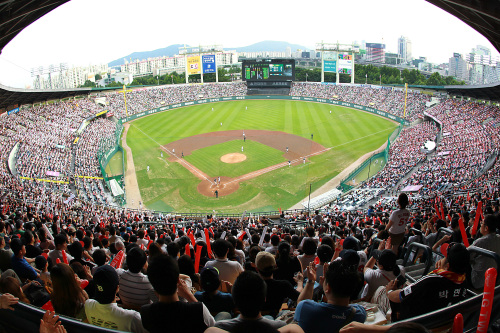It’s 6 p.m. on Sept. 16, and the Jamsil baseball stadium is already nearly filled.
“LG! LG!” a large squad in the first base stands starts chanting their club’s name as the match between the home team LG Twins and SK Wyverns begins.
“SK (clap-clap), SK (clap-clap),” another big crowd at third base shouts, slamming their stick balloons.
“I love cheering on my team, and I love the stadium atmosphere. It’s great fun,” says Ko Young-uk, an avid SK supporter.
Ko, 37, who is a particularly big fan of SK manager Lee Man-soo, says he comes to a baseball game almost every week.
“I can’t live without it,” he said.
Ko is among the many in this country who consider baseball their favorite sport. Since the professional league’s establishment in 1982, more than 100 million people have visited the ballparks at least once.
And the number of spectators is growing every year. Now with still two months to go before the end of 2011 season, the country’s top pro league has already drawn a record 6 million spectators, the highest number in its 30-year history, according to the Korea Baseball Organization, the league’s governing body.
Only 10 years ago, baseball had around 3 million visitors. The number dropped as low as 2.3 million in 2002, when the country was overwhelmed by the 2002 FIFA World Cup.
Things, however, started changing around 2006, when Korea finished fourth at the inaugural World Baseball Classic competition. In the 2007 season, the number of spectators surpassed the 4-million mark for the first time.
According to the KBO, the number of baseball fans has grown by leaps and bounds since the 2008 Beijing Olympics, where Korea won the gold medal in baseball. Also, their runner-up finish at the 2009 World Baseball Classic has helped attract more fans to the ballparks here.
“I think the quality of game and the performances of the players have improved a lot after the WBC, so more fans come to see the games,” said Ko.
Ward Rau, 60, from Chicago, visiting his daughter in Seoul, was in a Korean ballpark for the first time, and said that he was impressed with the atmosphere.
“The Jamsil stadium is beautiful. It looks like a major league stadium,” Rau said.
And he has also found something special in Korean baseball.
“Here everybody sits on one side for cheering one team, and the other side for another team. In the Major Leagues they don’t do it that way. You just buy the ticket and go sit anywhere. But it’s definitely more fun here,” he said.
Observers say the relentless effort and investment from the clubs is one of the main reasons behind the recent baseball fever here.
“Over the years the clubs have invested hugely in their marketing campaigns. And this helped a lot to attract more fans,” said Lee Jin-hyung, the PR manager of KBO.
According to Lee, the teams are now offering a variety of events and services targeting women and children.
The Doosan Bears, for instance, dedicate one day each month to their female fans, offering discount tickets and free cosmetics. The SK Wyverns have installed a powder room for their female fans and a playroom for children at the Muhak Stadium.
The Munhak ballpark, which was built in 2001, also offers a broad range of seating choices, such as a small grass bank where one can sit on a mat instead of a plastic chair, as well as two-seater wooden benches, creating a Major League-style atmosphere.
Experts believe the renaissance in baseball will continue for at least the next five years.
The good news is that NCsoft, an online game developer, has pledged to set up a baseball club with a new 25,000-seat ballpark in Changwon, South Gyeongsang Province. The KBO predicts the total number of spectators will surpass 7 million when NCsoft becomes the ninth pro baseball club here in 2013.
“There are also several companies that have shown interest in launching a baseball club. If we have 10th club, the number of spectators will soon reach 10 million,” said Lee.
But in order to reach another milestone, Lee said, more efforts are needed not only from the teams but also from the local governments.
Lee pointed out that the first thing is to allow clubs to use their stadium more freely.
Currently, there are eight teams in the league: Doosan Bears, LG Twins, Hanwha Eagles, Kia Tigers, Lotte Giants, Samsung Lions, SK Wyverns and Nexen Heroes.
Lotte’s home is the Sajik Stadium in Busan, and SK Wyvern’s Munhak Stadium is in Incheon. Doosan and LG share the Jamsil Stadium and Nexen uses the stadium in Mokdong in southwest Seoul. Hanwha has its home in Daejeon and Kia is in Gwangju.
However, all the stadiums are owned by the regional governments, and the teams use them on a short-term lease paying huge chunks of money.
Doosan and LG, for instance, pay around 3.5 billion won ($3.1 million) each year to the Seoul Metropolitan Government to use the Jamsil Stadium.
“The U.S. Major League teams pay as low as $1 for a 20-30 year lease to the government, so they can invest more on their stadiums and also offer more service facilities for fans,” Lee said.
Also, compared to Japan, the ballparks in Korea still lack some basic facilities for fans.
Yomiuri Giant’s Tokyo Dome stadium, for instance, is part of a greater entertainment complex, which includes a hotel, amusement park and also shopping malls.
But Seoul’s Jamsil Stadium has only a handful of fast-food restaurants and convenience stores to offer.
“Baseball is now a public sport as millions of people come to the stadiums. I believe the local governments should pay more attention and provide better services for the public,” Lee added.
By Oh Kyu-wook (
596story@herladm.com)






![[Herald Interview] 'Trump will use tariffs as first line of defense for American manufacturing'](http://res.heraldm.com/phpwas/restmb_idxmake.php?idx=644&simg=/content/image/2024/11/26/20241126050017_0.jpg)
![[Health and care] Getting cancer young: Why cancer isn’t just an older person’s battle](http://res.heraldm.com/phpwas/restmb_idxmake.php?idx=644&simg=/content/image/2024/11/26/20241126050043_0.jpg)
